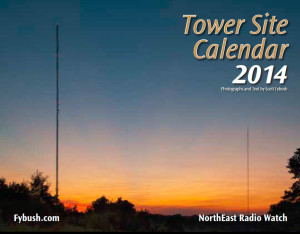NorthEast Radio Watch 12/8/2025: Cichon’s Back in Buffalo
In this week’s issue… Veteran newsman returns - Remembering NY's Leitner, RI's Jones - CT AM saved - Maine AM moves - "Indie" adds suburban signals
By SCOTT FYBUSH
We’re kicking off a big year in the history of NERW: the spring of 2014 will mark the twentieth anniversary of this column, and we’re planning a big celebration for all our loyal readers.
But before we get to the big two-oh, it’s time for our annual review of the year gone by. As we did last year, we’re bringing you Year in Review 2013 in a series of daily installments through New Year’s Eve, which we’ll collect on one page for archival purposes at the start of 2014.
Click here for Part 1: The Year in Station Sales
Click here for Part 2: Formats, People and Calls (January-June)
Click here for Part 3: Formats, People and Calls (July-December)
Click here for Part 4: Those We Lost
Click here for Part 5: Top Ten Stories, #10 – #6
Click here for Part 6: Top Ten Stories, #5 – #2
In this segment, we conclude our look at the top ten stories of 2013, as picked solely by your editor. Disagree with our choices? Have a comment? Come weigh in at the discussion boards on the RadioInsight Community. It’s where radio goes to talk radio, and we’re proud to be part of the team there!
[private]
The year’s top story, as NERW saw it, didn’t involve a single station, a single market or even a single band. Instead, it came from the regulatory arena and an FCC suddenly paying attention to broadcast again after several years of single-minded focus on broadband issues.
Congress played a role, too, pushing the FCC ahead on low-power FM with legislation that led the way to the first filing window for new LPFM stations in almost a decade. Delayed by the government shutdown that idled the FCC for the first half of October, the window ran through mid-November, yielding fewer applications than many had expected.
 Across the nine-state NERW region, only 305 applicants took part in the window, and several dozen of those were clearly defective. The FCC’s already moving with unusual haste to sort through the applications, with the first construction permits expected to be granted as early as January for those lucky applicants who filed “singleton” apps that were technically grantable and had no conflicts with other applications.
Across the nine-state NERW region, only 305 applicants took part in the window, and several dozen of those were clearly defective. The FCC’s already moving with unusual haste to sort through the applications, with the first construction permits expected to be granted as early as January for those lucky applicants who filed “singleton” apps that were technically grantable and had no conflicts with other applications.
Even those “MX” application groups, in almost every big city from Philadelphia to Buffalo, are on track for relatively quick resolution, and when the dust settles, NERW’s analysis suggests there will be about 140 new low-power FMs on the air across the region, spread out among schools and colleges, community groups, local governments and religious organizations.
But those new low-power signals will be just a small fraction of the new FMs filling the dial. For all the attention being paid to the LPFM movement, it’s translators that have really kept the spectrum active, and that trend will only continue into 2014.
With the LPFM window looming, the FCC moved quickly in 2013 to thaw out the longstanding freeze on thousands of translator applications filed back in the “Great Translator Invasion” window of 2003. Hundreds of long-dormant applications were resurrected, providing small windfalls to some canny applicants who’d filed for multiple frequencies a decade earlier and now found those construction permits in demand, whether by AM stations seeking FM signals or by FM stations looking to relay HD subchannels on analog translators. (Some owners did both: in Ithaca, Saga added two new translators to its cluster, one relaying an AM and the other an HD subchannel.)
It’s those translators – some of them, anyway – that are riding the edge between a full FM dial and an overly full FM dial. Just ask the full-power FM signals at the edge of the New York City market, many of them engaged in a fight to preserve their fringe listenership in the face of several construction permits attempting to share their channels from transmitter sites right in the city. We’ve been chronicling the fight over “Apple 107.1″‘s translator, now W292DV (106.3) and at least temporarily dialed back to just a few watts from a site in Long Island City, Queens, at the behest of co-channel WKMK (106.3 Eatontown NJ). But it’s not alone: “New Jersey 101.5” (WKXW-FM Trenton) has been rallying listeners in an attempt to keep another new translator off 101.5 in north Jersey.
(In practice, of course, many of those channels have already been blocked from fringe and even some local reception by the sea of pirates that continue to plague New York, north Jersey and Boston to an extent far beyond the understaffed FCC’s ability to keep up with them.)
Whatever channels are still open may yet be filled as the FCC moves ahead on another broadcasting agenda item. The Commission is currently taking comments on a sweeping set of proposals to “improve” the aging AM broadcast service. We put “improve” in quotes because the proceeding appears to be moving down two divergent tracks: some pieces of the plan call for technical changes aimed at preserving what’s left of listenership to actual AM signals, but a big piece of the agenda from many AM broadcasters seeks to do what most Canadian AM stations have long since done, effectively relocating AM stations to new homes on FM translator signals.
This much we can say with certainty: the days when the FM dial was open enough to offer any sort of usable out-of-market reception are gone now, and the most crowded FM spectrum in the country (and perhaps even the world, short of notoriously jammed Italy) is only going to keep getting more congested as the demand for new spots on the terrestrial FM band continues to give the lie to any claim that broadcast radio as we know it is dead, or even dying.
[/private]
That’s it for our Year in Review daily segments! They’ll be available as one big column on fybush.com beginning Thursday, January 2. We’ll be back with Tower Site of the Week on Friday, January 3 – and then the first regular NERW of 2014 on Monday, January 4.
 It’s become a legendary part of the broadcast landscape, found on the finest transmitter-site walls and in engineering offices from coast to coast and around the world.
It’s become a legendary part of the broadcast landscape, found on the finest transmitter-site walls and in engineering offices from coast to coast and around the world.
The 2014 Tower Site Calendar is ready to send for YOU (or someone else), spiral bound, shrink wrapped and best of all, with a convenient hole for hanging!
This year’s pinups include the iconic towers of Catalina Island, a combiner system in St. Louis, the twin towers of KNRS in Salt Lake City, a historic rooftop site in Jamestown, New York and many more!
Click here to order your 2014 calendar! We’re now shipping daily, so you can have your calendar on your wall before very much of 2014 has gone by…
In this week’s issue… Veteran newsman returns - Remembering NY's Leitner, RI's Jones - CT AM saved - Maine AM moves - "Indie" adds suburban signals
In this week’s issue… Scripps stations face takeover - Sinclair moves more affiliations - CT stations sold - Maine AM surrendered - Remembering WVBR's Shapiro, WABC's Morgan
In this week’s issue… CT TV legend succumbs to cancer - Remembering PA's Adams - FCC still stalled by shutdown - Pittsburgh morning host exits
In this week’s issue… FCC faces reopening challenges - Veteran Boston anchor retires - Morning shift in Toronto - NYC FMs expand reach